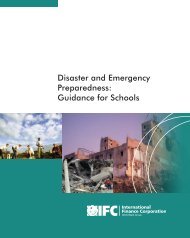Starting Up Child Centered Spaces in Emergencies: A Field Manual
Starting Up Child Centered Spaces in Emergencies: A Field Manual
Starting Up Child Centered Spaces in Emergencies: A Field Manual
- No tags were found...
Create successful ePaper yourself
Turn your PDF publications into a flip-book with our unique Google optimized e-Paper software.
PlayPlay allows children to relax and have fun. Play also allows children to socializewith other children and build self-esteem by master<strong>in</strong>g new skills. Play also canbe used by children to ga<strong>in</strong> a sense of control over difficult experiences such asthe tsunami.Ask children what other games they like to play. This approach sends a positivemessage that you are will<strong>in</strong>g to listen to the children and learn from them.<strong>Child</strong>ren also love to learn new games. What games did you play as a child? Ifthe children don’t know the game, teach it to them.Storytell<strong>in</strong>gStories can be told to children by the animator. These can be familiar folk tales<strong>in</strong> popular culture. You can read aloud from a book, or tell a story from memory.Vary your voice (for example, softer or louder), facial expression (for example,act<strong>in</strong>g surprised or frightened if it is part of the story), and body position (forexample, lean closer or take a few steps).S<strong>in</strong>g<strong>in</strong>gS<strong>in</strong>g<strong>in</strong>g together as a group is an excellent socializ<strong>in</strong>g activity. What are songsthe children like to s<strong>in</strong>g? Ask them! <strong>Child</strong>ren also love to clap to the rhythm, andyou can encourage this by example. S<strong>in</strong>g<strong>in</strong>g several songs at the beg<strong>in</strong>n<strong>in</strong>g orend of the day is a fun way for all children to be <strong>in</strong>volved.Danc<strong>in</strong>gAre there dances that the children know and like to do? Br<strong>in</strong>g the childrentogether <strong>in</strong> a circle and let all of them dance together. You can teach newdances that are not too difficult or complicated for the child’s developmentallevel.Participation By All <strong>Child</strong>renOne of the fundamental rights of children is the right to participate <strong>in</strong> their owndevelopment. Activities which <strong>in</strong>clude ALL children should be conducted eachday. For example, hav<strong>in</strong>g a structured activity where all the children s<strong>in</strong>g is verydifferent, and much better, than hav<strong>in</strong>g 100 children watch two or three of the“best” s<strong>in</strong>gers. The same is true for danc<strong>in</strong>g and most other activities. Whengroup games are be<strong>in</strong>g played, it is important to encourage all children to have anactive part. For example, if you notice that children pick only their friends or thesame people each time <strong>in</strong> a game, you should <strong>in</strong>tervene and say that each childcan have only one turn until all children get a turn. Includ<strong>in</strong>g all children as participants,rather than only observers, lets all children’s voices be heard, buildseach child’s sense of self-worth and promotes children’s healthy development.105
















